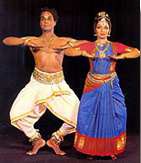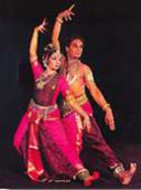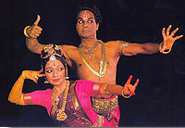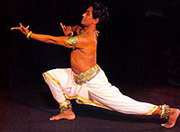Kuchipudi

Kuchipudi is one of the classical styles of Indian dance. Around the third and fourth decade of this century it emerged out of a long rich tradition of dance-drama of the same name.

In fact, Kuchipudi is the name of a village in the Krishna district of Andhra Pradesh. It is about 35 km. from Vijayawada. Andhra has a very long tradition of dance-drama which was known under the generic name of Yakshagaana. In 17th century Kuchipudi style of Yakshagaana was conceived by Siddhendra Yogi a talented Vaishnava poet and visionary who had the capacity to give concrete shape to some of his visions. He was steeped in the literary Yakshagaana tradition being guided by his guru Teerthanaaraayana Yogi who composed the Krishna-Leelatarangini. a kaavya in Sanskrit.

It is said that Siddhendra Yogi had a dream in which Lord Krishna asked him to compose a dancedrama based on the myth of the bringing of paarijaata flower for Sathyabhaama, the most beloved queen of Krishna. In compliance with this command Siddhendra Yogi composed the Bhaamaakalaapam which is till now considered the piece-deresistance of the Kuchipudi repertoire. Siddhendra Yogi initiated young Brahmin boys of Kuchipudi village to practice and perform his compositions particularly BHAAMAAKALAAPAM. The presentation of Bhaamaakalaapam was a stupendous success. Its aesthetic appeal was so great that the then Nawab of Golconda, Abdul Hasan Tanishah issued a copper plate in 1675 A.D. granting the village Kuchipudi as an Agrahaarama to the families of Brahmins who pursued this art. At that time all
the actors were male and the female impersonation was of a superb quality. To have an idea of the high standard of female impersonation one should see Vedaantam Satyanarayana Sharma, a great Kuchipudi dancer, even today doing the role of Satyabhaama.

The followers of Siddhendra Yogi wrote several plays and the tradition of Kuchipudi dance-drama continues till today. It was Lakshminarayan Shastry (1886-1956) Solo dancing was there earlier, but only as a part of the dance drama at appropriate sequences. 'At times, even though the dramatic situation did not demand, solo dancing was being presented to punctuate the presentation and to enhance the appeal. One such number is tarangam inspired by the Krishna-leela tarangini of
Teerthanarayana Yogi.who introduced many new elements including solo dancing and training of female dancers in this dance style.
To show the dexterity of the dancers in footwork and their control and balance over their bodies, techniques like dancing on the rim of a brass plate and with a pitcher full of water on the head was introduced. Acrobatic dancing became part of the repertoire. By the middle of this century, Kuchipudi fully crystallized as a separate classical solo dance style. Thus there are now two forms of Kuchipudi; the traditional musical dance-drama and the solo dance.
From the later part of the fourth decade of this century a sequence of the presentation of the solo recital has been widely accepted. A recital of Kuchipudi begins with an invocatory number, as is done in some other classical dance styles. Earlier the invocation was limited to Ganesha Vandana. Now other gods are also invoked. It is followed by NRITTA, that is, non-narrative and abstract dancing. Usually jatiswaram is performed as the NRITTA number. Next is presented a narrative number called SHABDAM. One of the favourite traditional shabdam number is the Dashaavataara. The SHABDAM is followed by a natyanumber called Kalaapam. Many Kuchipudi dancers prefer to perform entry of Satyabhama from the traditional dance-drama Bhaamaakalaapam. The song "bhamane, satyabhamane, the traditionalpraveshadaaru (the song that is rendered at the time of the entry of a character) is so tuneful that its appeal is universal and ever fresh. Next in the sequence comes a pure nrityaabhinaya number based on literary-cum musical forms like padam, jaavli, shlokam, etc. In such a number each of the sung words is delineated in space through dance, drishya-kavita (visual poetry). A Kuchipudi recital is usually concluded with tarangam. Excerpts of Krishna-leela-tarangini are sung with this number. In this the dancer usually stands on a brass plate locking the feet in shakatavadanam paada and moves the plate rhythmically with great dexterity.
The music that accompanies the dance is according to the classical school of Carnatic music and is delightfully syncopatic. The accompanying musicians, besides the vocalist are: a mridangam player to provide percussion music, a violin or veena player or both for providing instrumental melodic music, and a cymbal player who usually conducts the orchestra and recites the sollukattus(mnemonic rhythm syllables).
